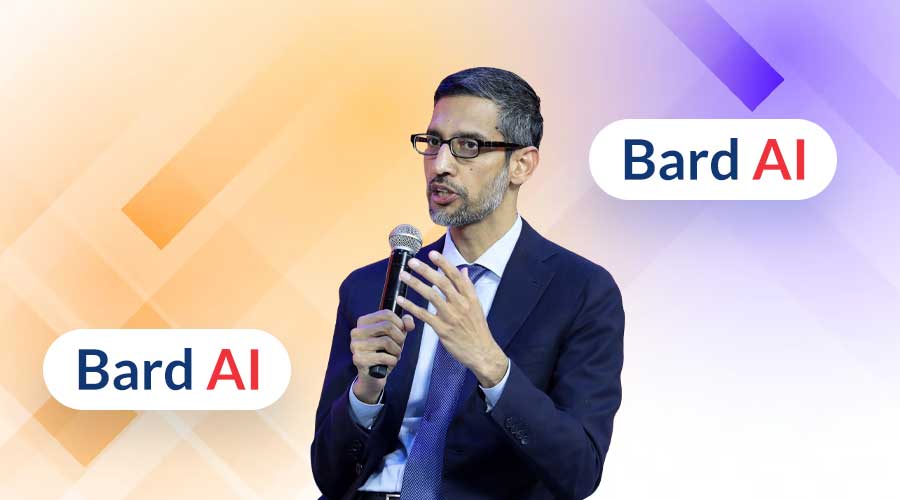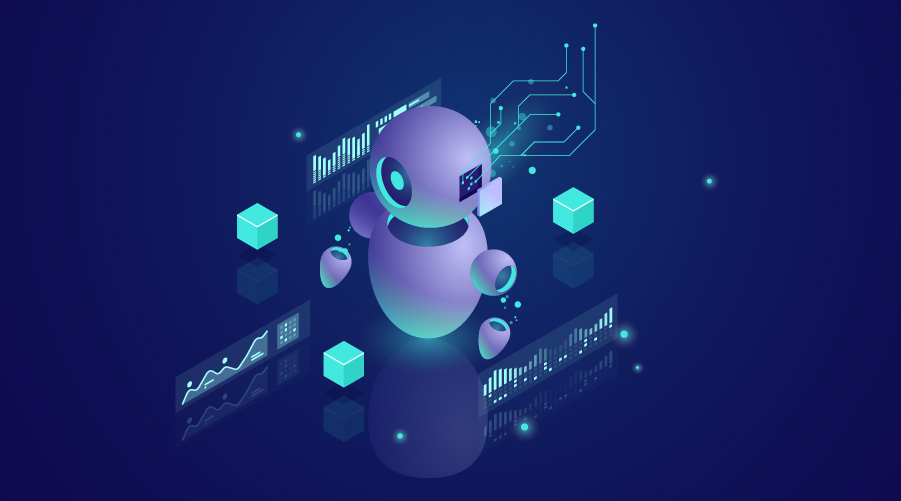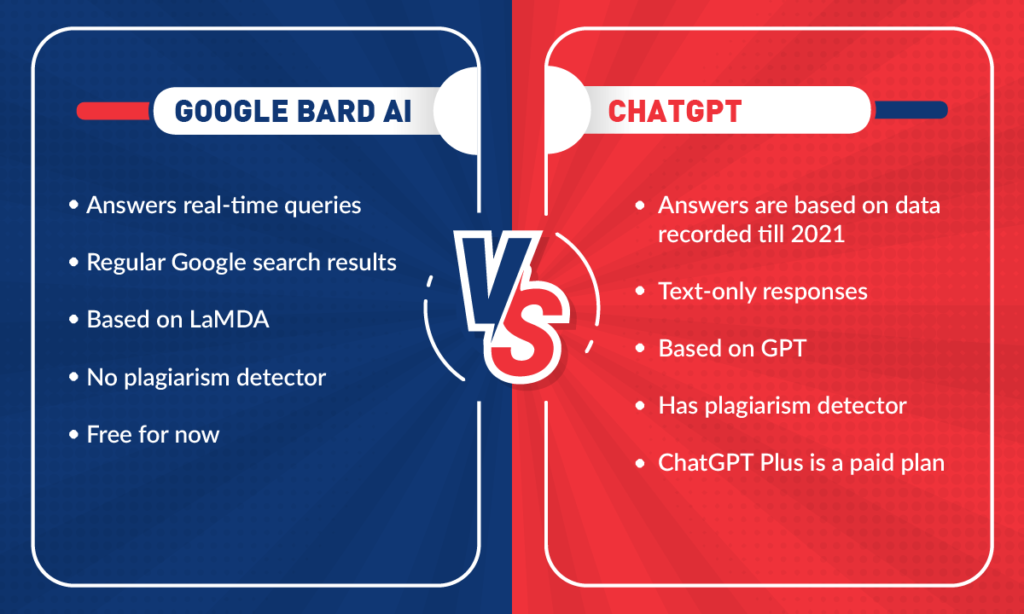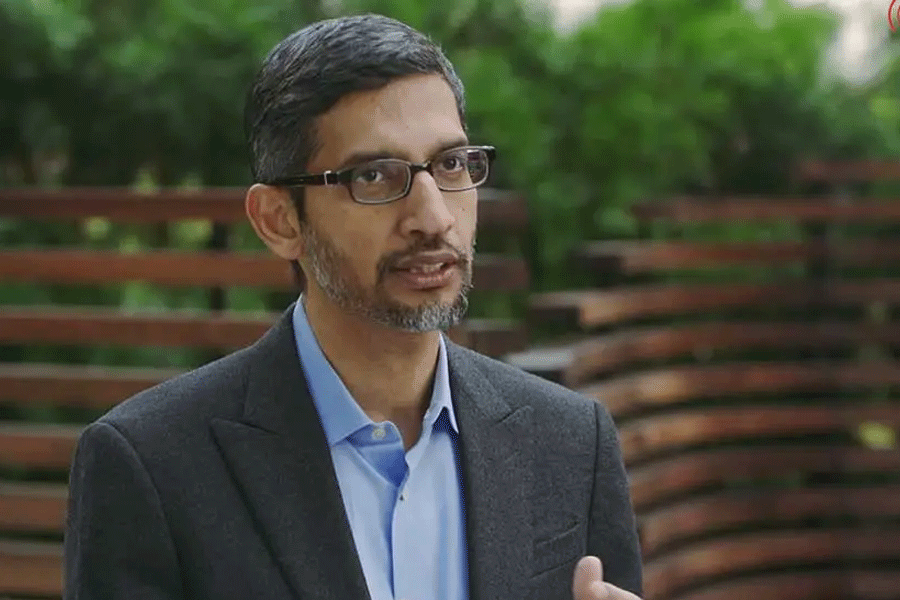After OpenAI’s ChatGPT’s success in the AI space, Google CEO Sundar Pichai recently introduced Google Bard, staking its claim to this market.
The purpose of AI, or Artificial Intelligence, is to create intelligent machines that can perform tasks that typically require human intelligence, such as recognizing speech, understanding natural language, making decisions, and identifying patterns.
In a world that is constantly changing due to artificial intelligence, large tech companies like Google and Microsoft become significant torch-bearers of a fast-evolving sector (AI).
Table of Contents
- Introducing Google Bard
- The Making of Bard
- The Workings of the AI-powered Bard
- How to access it?
- One look at its features
- Examples and use cases scenarios
- The Potential of Bard with AI
- Battle of the Language Models: Microsoft’s Chat GPT vs Google’s Bard
- Controversy
- What’s next for AI in big tech?
- How did the markets react?
Introducing Google Bard
Google AI developed a text generation model called Google Bard, which is designed to generate poetry and lyrics conversationally.
It uses advanced artificial intelligence techniques such as natural language processing and machine learning to understand the patterns, structure, and themes of human language.
The name “Bard” refers to a poet, storyteller, or performer in traditional Gaelic and Welsh culture, and the tool is designed to help users create poetry and lyrics in a similar way to how a traditional bard might.
The goal of Google Bard is to enable users to create coherent and engaging poetry and lyrics without needing a deep understanding of the art form or having any previous experience in writing.

The market share now held by Chrome is the highest. Similar to how there were other operating systems before Google released Android, Android currently controls the mobile OS industry.
Google has also announced the launch of the conversational AI chatbot “Bard,” which comes in response to the growing popularity of Microsoft-backed ChatGPT.
It should be emphasised that Google didn’t do well when it came to product launches. Due to WhatsApp’s widespread use, it released the Allo instant messaging smartphone app but it was unable to gain traction.
Focusing on creating a fantastic product and ethically developing it is currently the most crucial thing we can do, according to Sundar Pichai. The statement “this will be a long journey for everyone, across the field” was included in his remarks.
The Making of Bard
Google Bard was created using a deep learning algorithm called GPT-3 (Generative Pre-trained Transformer 3), which OpenAI developed.
Google AI, the research division of Google, licensed access to GPT-3 to create the poetry and lyric generation tool.
To create Google Bard, the Google AI team fine-tuned the GPT-3 model on a specific dataset of poetry and lyrics. The dataset included a wide range of texts from different genres and periods, including classic poems, contemporary pop lyrics, and Shakespearean sonnets.
The team used a technique called unsupervised learning to train the GPT-3 model on the poetry and lyrics dataset.
This involved feeding the model large amounts of text and allowing it to learn patterns and structures in the language without explicit guidance or feedback from humans.
Once the GPT-3 model was trained on the poetry and lyrics dataset, the Google AI team integrated it into the Google Bard interface.
Users can enter a prompt or topic, and the tool will generate a poem or lyrics based on the input. The output can be customized by selecting different styles or genres, adjusting the length of the output, and changing the language and tone of the text.
Overall, Google Bard was created through a combination of advanced artificial intelligence techniques, including deep learning, unsupervised learning, and natural language processing.
The tool was designed to be user-friendly and accessible to individuals who may not have a deep understanding of poetry or lyric writing.
The Workings of the AI-powered Bard
The model is based on a type of neural network architecture known as a Transformer, which was first introduced in a 2017 research paper by Google researchers.
Here’s a high-level overview of how Google Bard works:
Input: The user provides a prompt or topic for the poem. The Google Bard is designed to work with a wide range of topics, from broad themes like love and nature to specific objects or events.
The user can also specify the desired length and form of the poem.
Language model: it uses a pre-trained language model to generate text that is grammatically correct and coherent.
This language model is based on a type of neural network known as a Transformer, which is capable of analyzing large amounts of text data and generating new text based on that data.
Poetic structure: Once it has generated the base text, it applies rules of poetic structure and style to create a poem that adheres to the desired form.
For example, if the user specifies that they want a sonnet, the Google Bard will ensure that the poem has 14 lines and follows a specific rhyme scheme.
Optimization: Finally, it uses a process called “beam search” to generate multiple candidate poems and select the most suitable one.
Beam search involves generating multiple variations of the poem and scoring each variation based on criteria such as coherence, creativity, and conformity to the desired form.
The Google Bard then selects the poem with the highest score and presents it to the user.
Google Bard is a highly sophisticated language model that leverages deep learning techniques to generate original poetry in response to user prompts.
While it may not be able to match the creativity of human poets, it is capable of producing surprisingly compelling and coherent poems, making it a useful tool for anyone interested in exploring the possibilities of AI-generated art.
How to access it?
To use Google Bard, one must be selected from the beta tester group. If desired, you can simply type in your prompt or request by opening the Google app on your smart device, tapping the chatbot icon, and selecting.
You can now start posing your queries or requesting things, and the dialogue will officially begin. Regrettably, Google is no longer taking applications to join the Beta Testing team.
One look at its features
The features of Google Bard AI make it a powerful tool for a wide range of language-related tasks, from communication to content creation to analysis.
- Multilingual capabilities:
Despite the fact that they can’t actually carry on conversations like people, chatbots frequently give the idea that they can by generating a wide range of digital text that can be applied to practically any circumstance.
Google’s chatbot attempts to do this with almost any topic that is offered to it by:
- attempting to show how power, intelligence, and creativity can coexist
- collecting information from internet reviews and client feedback
- LaMDA light model version for initial testing
- gathering recommendations for future AI system improvements
The AI can translate and understand text in over 100 languages, making it useful for international communication and business.
- Improved conversational abilities:
Bard AI is designed to respond to conversational prompts in a more natural and intuitive way, making it ideal for chatbots and virtual assistants.
- Enhanced creativity:
The AI has the ability to generate original content, including poetry, song lyrics, and prose, with a high degree of sophistication and fluency.
- Improved accuracy:
Bard AI has been trained on massive amounts of data, making it highly accurate in understanding the nuances of human language, including slang and informal language.
- Personalization:
The AI can be customized to specific domains, such as legal or medical language, making it useful for specialized applications.
- Continuous learning:
The AI is designed to learn continually from user interactions, which means it can adapt and improve over time.
- Integration with other Google services:
Bard AI can be integrated with other Google services, such as Google Search and Google Assistant, making it easier to use and more powerful.
- Large-scale applications:
Bard AI can handle massive amounts of data, making it useful for applications such as language translation, content generation, and sentiment analysis.
Examples and use cases scenarios
Bard has a wide range of use cases and can be applied in various industries where creative writing is required.
With its ability to generate coherent and expressive language, it has the potential to transform how we communicate with each other and interact with technology.
Here are some use cases where Bard can be applied:
- Songwriting:
Bard can generate lyrics for songs in a variety of genres, including pop, rock, country, and hip-hop. It can generate lines that fit a specific rhyme scheme or meter and can even suggest melodies to match the lyrics.
Musicians and songwriters can use this tool to find inspiration, overcome writer’s block, or generate ideas for new songs.
- Creative Writing:
It can generate poetry, short stories, and even entire novels. It can create new characters, describe settings and events, and weave together plots and story arcs. Writers can use this tool to explore new ideas and experiment with different styles and techniques.
- Marketing and Advertising:
Can be used to create copy for marketing materials such as ads, product descriptions, and social media posts. It can generate engaging and persuasive language that is tailored to a specific audience or demographic.
- Chatbots:
Integration into chatbots can create more engaging and personalized conversations with customers. It can generate responses that are tailored to the user’s input and can adapt to changes in the conversation.
- Virtual Assistants:
To create a more natural and expressive language for virtual assistants such as Siri or Alexa. It can help these assistants better understand user requests and generate more human-like responses.
- Education:
In educational settings, it can help students learn how to write creatively. It can generate writing prompts, provide feedback on student writing, and even create collaborative writing projects.
The Potential of Bard with AI

People can find what they’re seeking for more quickly and readily thanks to the improved chances that current AI provides for improving our understanding of information and efficiently converting it into knowledge.
When it’s important to combine concepts for issues that don’t have a single correct solution, AI can be helpful.
The potential of Google Bard is significant, as it represents a major step forward in the field of natural language generation.
- The ability to create original poetry is a challenging task for machines, as it requires not only an understanding of grammar and syntax, but also an appreciation of the subtleties of language, including meter, rhyme, and other literary devices.
- With Google Bard, it is possible to create high-quality, original poetry quickly and easily. This has a number of potential applications, including in the fields of education, entertainment, and marketing.
- In education, it could be used to teach students about poetry, allowing them to experiment with different forms and styles. It could also be used as a tool for generating writing prompts, or as a means of providing feedback on student work.
- In entertainment, it could be used to generate song lyrics or other types of creative content. It could also be used in the development of video games, where poetry is often used as a storytelling device.
- In marketing, it could be used to generate advertising copy or other types of promotional materials. This would allow companies to create personalized and engaging content that speaks directly to their target audience.
Eventually, AI-powered Search tools will be able to condense complex data and a range of viewpoints into rapid and understandable formats. These new AI functions will soon be made available through Google Search.
Battle of the Language Models: Microsoft’s Chat GPT vs Google’s Bard

It’s crucial to mention for those who are unaware of the hype around the Bard vs. ChatGPT debate that Microsoft, Google’s main competitor, just disclosed its plans to invest $10 billion in ChatGPT’s success.
However, many analysts believe that the IT giant is under a lot of pressure to catch up to Open AI’s ChatGPT, which inspired the development of Bard AI as well.
Although it is unknown whether Bard can take the role of ChatGPT or the other way around, the following should be mentioned:
Bard’s operation will be supported in large part by Google’s LaMDA, which sources all of its data from the internet. Nevertheless, ChatGPT can only access data through 2021, therefore it is still unknown whether there will be space for more.
Even though ChatGPT Plus is a premium edition, it is also readily accessible to the general public for free. Yet as far as Google’s Bard is concerned, the AI tool is currently only accessible to a small number of people for testing and will be made available to everyone very soon.
The Difference
- Google Bard AI will be able to respond to queries in real-time. Based on data through 2021, ChatGPT’s responses.
- While ChatGPT only returns text results, using Google Bard AI produces traditional search results with just a minor adjustment to the Google settings. Although Google Bard is based on LaMDA, ChatGPT is based on GPT.
- Google Bard does not yet have a plagiarism checker, although ChatGPT’s AI Text Classifier does.
- Google Bard AI is currently uncharged. ChatGPT Plus, a new premium service from OpenAI, has just been released.
Controversy
Prior to ChatGPT, LaMDA held the title of the most divisive AI chatbot in the world for a number of months.
LaMDA was published, but soon afterwards, former Google engineer Blake Lemoine stirred up controversy by issuing a document in which he asked the company to take into account the possibility that LaMDA might be “sentient.”
Then, in December, a new chatbot caught the attention of the general public: OpenAI released its ChatGPT, a so-called large language model that functions via a chat interface like LaMDA. Since then, ChatGPT is the only significant language model application that is mentioned.
Blake Lemoine was placed on paid administrative leave before being fired from his position at the firm after Google disputed the existence of sentience. In the months that followed, the debate subsided.
The major drawback of AI chatbots is shown by this error, underscoring the necessity of a thorough testing procedure. To combat ChatGPT’s fierce rivalry in their comparatively untapped ecosphere, Google is making an effort to improve Bard’s responses and reach a high standard for quality in real-world information.
What’s next for AI in big tech?
AI is the most ground-breaking technology being developed at the moment. By facilitating earlier disease diagnosis and enabling users to access information in their local tongue, AI helps people, businesses, and communities realise their full potential.
Also, it opens up new opportunities that could significantly improve the lives of billions of people. We reoriented the company around AI six years ago in order to achieve our goal of organising the world’s knowledge and making it widely accessible and valuable.
As a result, we believe that using AI will be the most effective way for us to complete this task.
The problem will be to make the rules accurate enough to be useful without being too precise, given AI is an area that is advancing at a breakneck pace.
A long-overdue age of AI development with greater respect for privacy and justice may begin in the coming year, similar to EU efforts to govern data protection if new regulations are correctly applied.
All of these rules could influence how tech businesses create, employ, and market AI technologies.
Tech lobbyists are not hesitant to remind authorities that they must strike a delicate balance between safeguarding consumers and preventing the slowing of innovation.
How did the markets react?
Shortly after its new chatbot accidentally revealed misleading information in a promotional video, Google Inc. saw a $100 billion decline in market value. Microsoft’s shares dropped as much as 9% during regular trading while they increased by over 3% before giving back part of their gains.
The error was first brought to light by Reuters in Google’s marketing for Bard, a chatbot that made its debut on Monday. It was addressed in the article whose satellite became the first to take pictures of a planet outside of our solar system.
Since OpenAI, a company Microsoft is investing $10 billion in, unveiled software in November that amazed users and became a craze in Silicon Valley circles for its shockingly accurate and well-written responses to straightforward questions, Google has been reeling.
